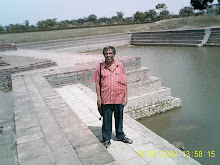The distribution of disease is not equal across all people in a state. People at risk need more public health services and those who are sick need more medical (hospital) services. If everyone got what they needed- silicosis and injury treatment in Asansol coal mines, drowning and snakebite treatment in Sundarbans islands, malaria spraying and treatment in Jalpaiguri tea gardens- this would not be equal or exactly the same everywhere- but it would be appropriate and Fair. The fair distribution of resources is called equitable (see Amartya Sen's writing on this- eg Pratichi Health report on the internet).
Economic factors like poverty can make it difficult for this
boy in Murshidabad to reach Behrampore. His father is blind and his mother and
siblings have similar limb weaknesses. Another factor may be that he has no
relations to stay with there or who know the health staff.
If he had disease
like TB- which is considered very unacceptable in some rural areas (I remember
a health worker in Memari who would not tell anyone that he was taking
Streptomycin injections in 1990)- he might face stigma as well. Leprosy and
nowdays HIV are reviled by many more.
What has been the response of the Planning Commission, the
WHO, the Government of India and Civil Society to these issues?
This is a list of some recent Equity related Resolutions
Does poverty men that we get less preventive care? Ccording
to the WHO, Government and State policies everyone has equal access. But look
at the data from a UNICEF- Government study in 2009.
Thus far for service statistics. Will this affect more
obvious indicators like mortality (deaths). Have a look at the UNICEF-
Government joint study called MAPEDIR in Purulia from 2005 to 2010
Even Literacy appears to affect the chances of dying.
We do not expect community to be a factor in the land of
Rabindranath and Nazrul- but look at the data-
Of course some communities are over represented in the lower
economic section- so it is not easy to say which came first- poverty or
backwardness. However this means that aany effort at immunization must either
measure the effect on Below Poverty Line families (if this is correctly
identified) or use community as a proxy for BPL status.
Even the place of immunization depends on community. This
may be because PHC land has been donated closer to certain types of villages/
towns throughout the state or because certain communities make more use of
Anganwadi Centres.
There are also geographic reasons for unequal health
services- hard to reach areas
The surprising fact is that diseases are also more common in
certain places. It is good to map the disease surveillance data. This helps to
decide where to focus our preventive or curative work. See the following map of
measles in Uttar Dinajpur prepared by NPSP based on 2008 to 2010 data-
Maybe we should teach budding doctors about social factors in health and disease. And a bit of geography too. A bit about equity too. Am still learning- a quarter of a century into the adventure.












No comments:
Post a Comment